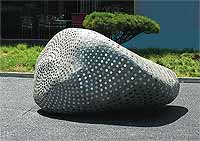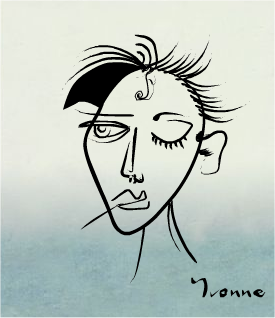As Bo is
moving to Cambridge, it brought back memories...
Cambridge is in many ways a strangely schizoid place. It is divided between town and gown - there's even a pub name commemorating this deep divide. The university was founded in the 14th century after some academics fled from Oxford after the people of Oxford rioted in protest against the oppressive behaviour of that university. Accordingly, the Cambridge colleges appear to have been built to withstand a siege; they have ditches and banks and cast-iron fences. They also own most of the river bank between Midsummer Common and Silver Street, and only members of the college can sit upon the hallowed lawns. That said, most of the colleges do let local residents into the tourist bits for free, which is nice. But the university once had enormous power. In the nineteenth century, an unaccompanied woman walking around at night could be arrested by the university proctors for soliciting.
I love the hidden corners of Cambridge, the architectural surprises. If you look up and in side streets, there are often quirky features of buildings - the
gateway of Gonville and Caius college for example. There's also the splendid lamp-post in the middle of Parker's Piece, which traditionally has "
REALITY CHECKPOINT" graffitied onto it. Last time I went, it was still there. Another architectural oddity is the Round Church, originally a Templar church; it has Romanesque architecture, but it's round. The Templars also had a cave in Royston - a bell-pit carved into the chalk which was rediscovered in the eighteenth century.
Then there's the stories that accumulate. Apparently Aleister Crowley was so smelly that his fellow students forced him to take a shower in the fountain of Trinity College; and Byron was so mad that he took showers there voluntarily. There's also a pool on the river Granta called Byron's Pool where he is supposed to have swum regularly. A popular Cambridge urban myth used to be the story that some students substituted a polystyrene ball for one of the stone balls on a bridge over the river Cam, and proceeded to push it off as a punt-load of other students was going underneath, causing them all to jump into the river. Another myth tells that one student dressed as a porter and another student walked across the lawn, complete with a sachet of fake blood under his shirt, and then the one dressed as a porter pulled out a fake gun and "shot" him, much to the consternation of a passing group of American tourists. Another story (untrue, alas) tells that Isaac Newton built the Mathematical Bridge without any bolts - it was just held together by geometry - and the other dons took it apart to see how he'd done it; but then they couldn't put it back together again without using nuts and bolts.
There are many literary associations in and around Cambridge. A E Housman was at Trinity. Rupert Brooke and Rose Macaulay used to hang out on Grantchester Meadows with their fellow "Neo-Pagans". Of course Brooke's poem about Grantchester is well-known (though its comic aspects are often forgotten), but he got the time wrong - the church clock was not stuck at ten to three, it was actually quarter to eight (but they moved the hands after he became famous for being a far-flung outpost of England in a foreign field). Aleister Crowley went to school in Bateman Street (but cursed anyone who looked upon the place; I'm doomed then, as I used to live two doors down from it) and later lived at 12 Portugal Place.
Grantchester Meadows are idyllic, and a great place for walks. I once went there to do a solo Midsummer ritual, and there was a party of hippies there playing the violin (rather well, I might add); quite magical.
Cambridge is also home to two fabulous museums: the Museum of Archaeology and Anthropology (like the Pitt-Rivers but bigger), and the Fitzwilliam Museum (which is like a mini-British Museum). I have spent many happy times there. The Fitzwilliam has a massive collection of Blake engravings which I never got to see; but I did see an exhibition of Hokusai there, and also paintings of Antarctica and volcanoes and stars by a wonderful artist whose name I forget. Another great place to visit is the Botanical Gardens; these used to be free of charge one day a week. They have enormous drifts of snowdrops and daffodils in spring, and a lovely grove of birch trees, and a brilliant winter garden with plants that have vivid colours in winter, like the beautiful Chinese rainbow birch.
Oddly two of the parks are named after Pagan festivals: Midsummer Common (where
Strawberry Fair is held) and Lammas Land.
The pubs are quite characterful - I used to work in the Cambridge Blue (you had to have a degree to work there), and became good friends with the other bar staff, including
Ruth Bagnall (sadly no longer with us) and Jane W, who then went on to work in the Boat Race as a music promoter. I tended to go in the pubs around Mill Road, but there are other good ones in the town centre. There's also a brilliant vegetarian place just up the road from King's College called the Rainbow Café. I sometimes went to the Tap and Spile, and once was playfully pushed into the river by a former Pink Floyd roadie while I was holding a pint of bitter. If I hadn't been holding a pint, I would only have gone in up to my ankles, but since I was trying to balance the pint I ended up sitting in the water (didn't spill a drop of the pint though). So I went for a quick swim in the river, and then climbed out and gave the said roadie a big wet hug, so he was almost as wet as me.
Bookshops are plentiful, as you might expect. The
Libra-Aries bookshop on Mill Road is the Pagan and alternative bookshop. It wasn't there when I lived in Cambridge but we met the owners at a Pagan event a couple of years ago; they are lovely and very knowledgeable. In my day, the Pagan bookshop was the Ninth Wave (named after the Kate Bush song). In the centre of town, there's Heffers and the Cambridge University Press bookshop.
Some of the college chapels are wonderful - I went to a Tallis concert in Trinity chapel once, and the acoustic was amazing and made the music pour down the walls and float into your ears like a pale blue crystalline mist. Trinity chapel also has a Baroque interior and a black-and-white tiled floor. The atmosphere in the chapel of "Porterhouse" is so thick you could cut it with a knife.
I loved Cambridge, but it wasn't a good place for jobs unless you were a Cambridge graduate - that's why the landlord of the Cambridge Blue could stipulate that bar staff must have a degree. I applied for a PhD once, but the interviewer spent most of the interview staring at the ceiling, except when I told him I read French and German. I didn't get in. It could be frustrating sometimes, being on the outside of a hive of intellectual activity, unable to participate. However, I did write my first two books while living in Cambridge, got involved in Wicca there, and had a relationship with a wonderful bloke with whom I moved to Scotland in 1994. We split up eventually (in part because he didn't get Paganism) but I wish him well.
 If you're down in Devon in September, don't miss Devon Open Studios, 10.30 am - 4.30 pm, 6th, 7th and 8th September 2008.
If you're down in Devon in September, don't miss Devon Open Studios, 10.30 am - 4.30 pm, 6th, 7th and 8th September 2008.

